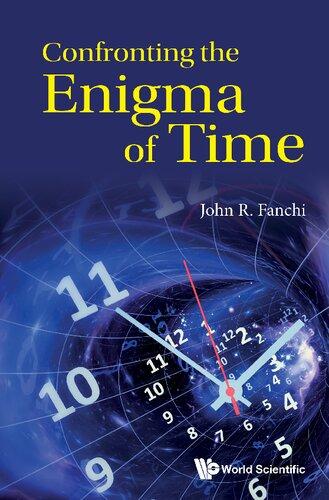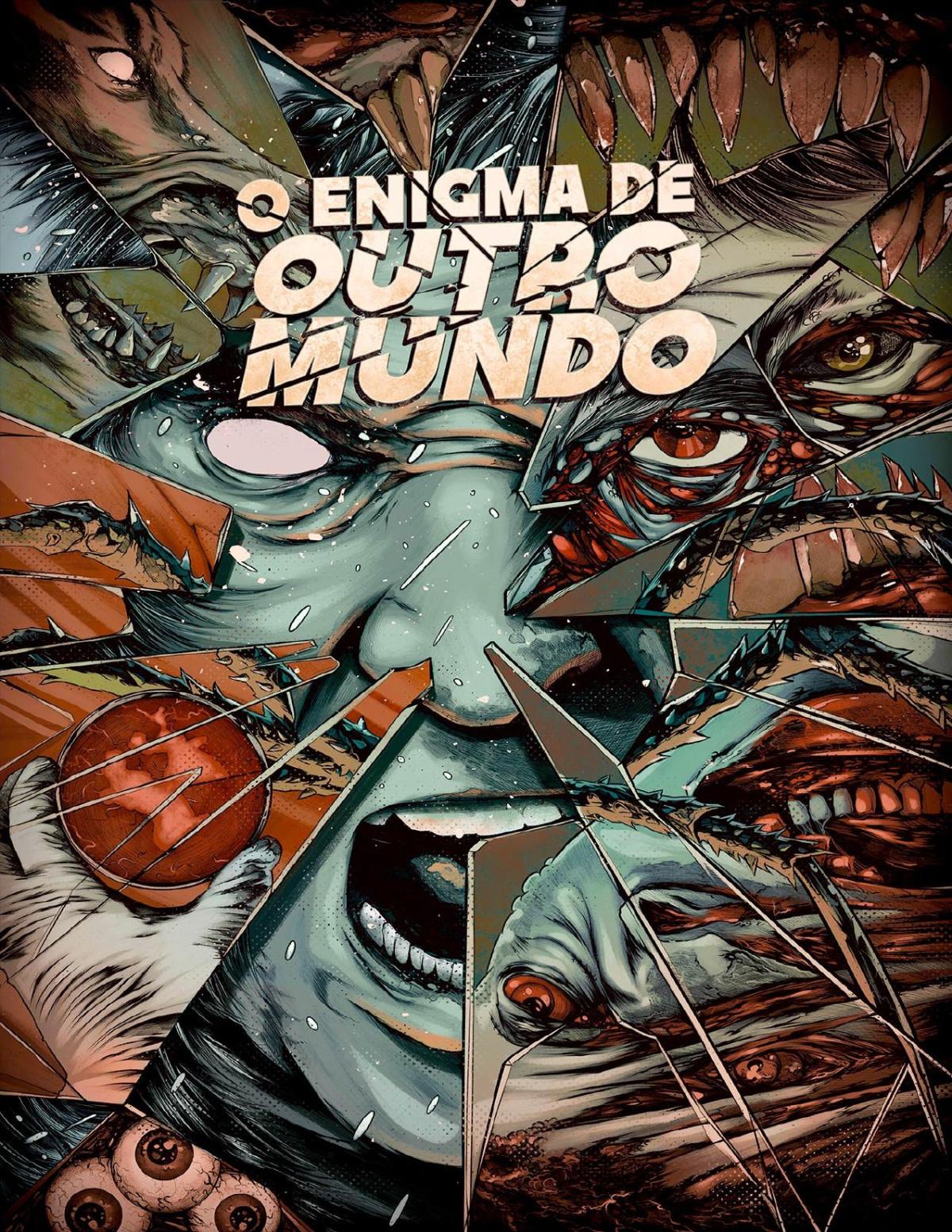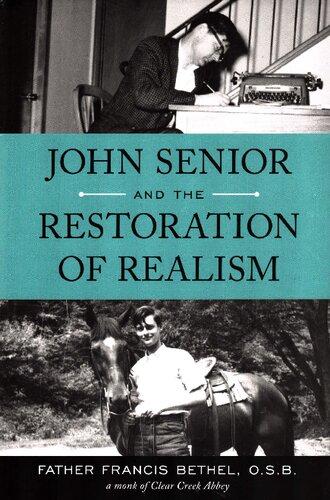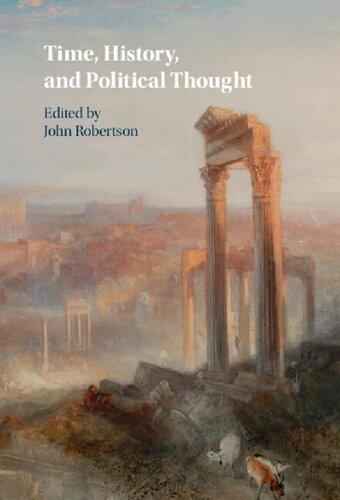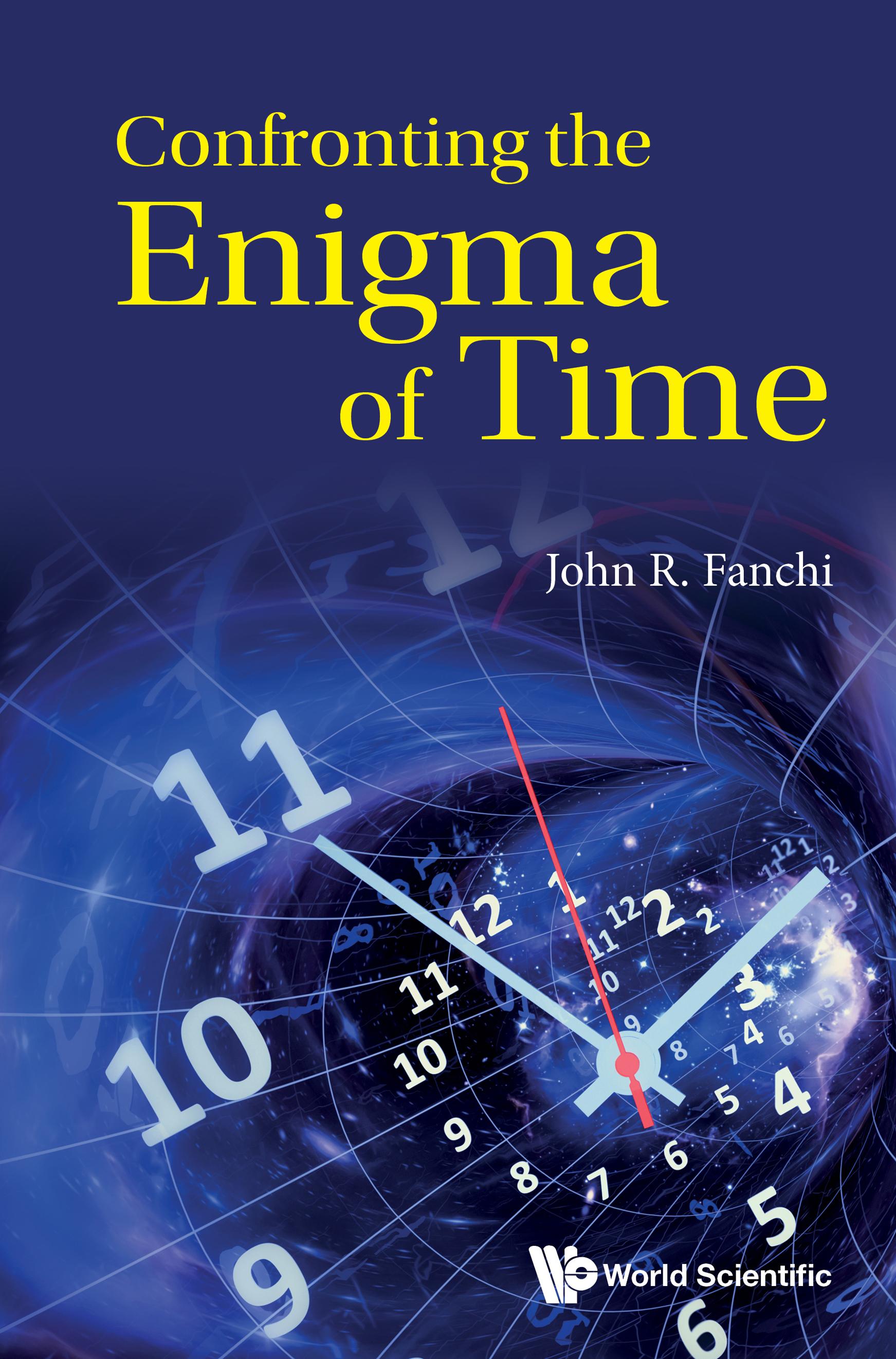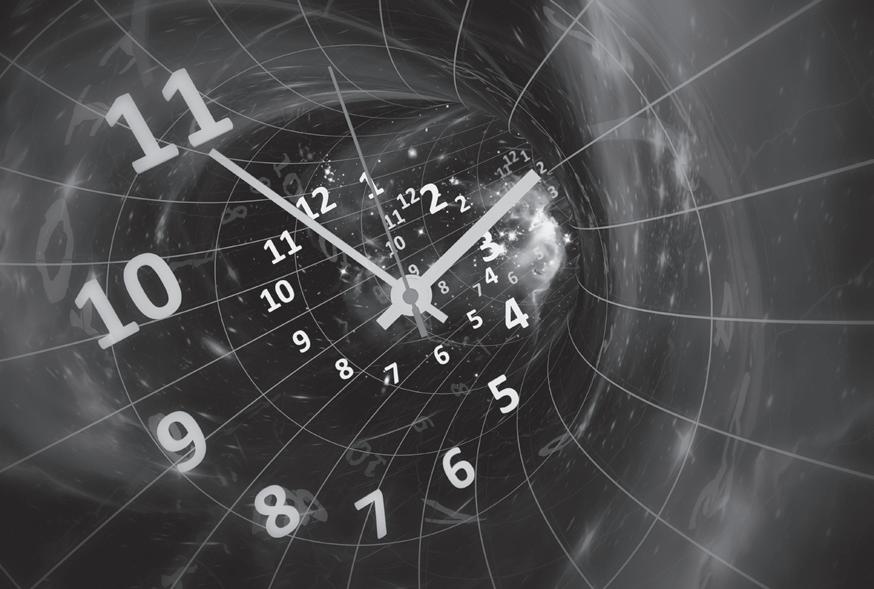Visit to download the full and correct content document: https://ebookmass.com/product/confronting-the-enigma-of-time-john-r-fanchi/
More products digital (pdf, epub, mobi) instant download maybe you interests ...
Legacy of Time: The Story of John, the Greatest Time Traveler of All Time Sara Bahou
https://ebookmass.com/product/legacy-of-time-the-story-of-johnthe-greatest-time-traveler-of-all-time-sara-bahou/
The Logic of Immunity: Deciphering an Enigma Bobby Joseph Cherayil
https://ebookmass.com/product/the-logic-of-immunity-decipheringan-enigma-bobby-joseph-cherayil/
O enigma de outro mundo John W. Campbell [Campbell
https://ebookmass.com/product/o-enigma-de-outro-mundo-john-wcampbell-campbell/
Intelligence Analysis: Domestic and Foreign Threats
Confronting the Biden Administration John Michael Weaver
https://ebookmass.com/product/intelligence-analysis-domestic-andforeign-threats-confronting-the-biden-administration-johnmichael-weaver/
Essentials of Fluidization Technology John R. Grace
https://ebookmass.com/product/essentials-of-fluidizationtechnology-john-r-grace/
John Senior and the Restoration of Realism R. Scott
Moreland https://ebookmass.com/product/john-senior-and-the-restoration-ofrealism-r-scott-moreland/
Future War and the Defence of Europe John R. Allen
https://ebookmass.com/product/future-war-and-the-defence-ofeurope-john-r-allen/
Sonny: The Last of the Old Time Mafia Bosses, John "Sonny" Franzese S. J. Peddie
https://ebookmass.com/product/sonny-the-last-of-the-old-timemafia-bosses-john-sonny-franzese-s-j-peddie/
Time, History, and Political Thought John Robertson
https://ebookmass.com/product/time-history-and-political-thoughtjohn-robertson/
TTThhhiiisss pppaaagggeee iiinnnttteeennntttiiiooonnnaaallllllyyy llleeefffttt bbblllaaannnkkk
Published by
World Scientific Publishing Europe Ltd.
57 Shelton Street, Covent Garden, London WC2H 9HE
Head office: 5 Toh Tuck Link, Singapore 596224
USA office: 27 Warren Street, Suite 401-402, Hackensack, NJ 07601
Library of Congress Cataloging-in-Publication Data
Names: Fanchi, John R., author.
Title: Confronting the enigma of time / John R. Fanchi, Texas Christian University, USA.
Description: New Jersey : World Scientific, [2023] | Includes bibliographical references and index.
Identifiers: LCCN 2022032911 | ISBN 9781800613188 (hardcover) | ISBN 9781800613348 (paperback) | ISBN 9781800613195 (ebook) | ISBN 9781800613201 (ebook other)
Subjects: LCSH: Space and time--History. | Time--History.
Classification: LCC QC173.59.S65 F36 2023 | DDC 530.11--dc23/eng20221013 LC record available at https://lccn.loc.gov/2022032911
British Library Cataloguing-in-Publication Data
A catalogue record for this book is available from the British Library.
Copyright © 2023 by World Scientific Publishing Europe Ltd.
All rights reserved. This book, or parts thereof, may not be reproduced in any form or by any means, electronic or mechanical, including photocopying, recording or any information storage and retrieval system now known or to be invented, without written permission from the Publisher.
For photocopying of material in this volume, please pay a copying fee through the Copyright Clearance Center, Inc., 222 Rosewood Drive, Danvers, MA 01923, USA. In this case permission to photocopy is not required from the publisher.
For any available supplementary material, please visit https://www.worldscientific.com/worldscibooks/10.1142/Q0389#t=suppl
Desk Editors: Jayanthi Muthuswamy/Adam Binnie/Shi Ying Koe
Typeset by Stallion Press
Email: enquiries@stallionpress.com
Printed in Singapore
To my grandchildren Cameron, Caleb, and Luke
TTThhhiiisss pppaaagggeee iiinnnttteeennntttiiiooonnnaaallllllyyy llleeefffttt bbblllaaannnkkk
Preface
Confronting the Enigma of Time examines the role of time in modern physics. The enigma of time is a conceptual conflict between the two leading theories of modern physics: relativity and quantum theory. It raises the question of the fundamental nature of time in a physical sense. Attempts to unify the two theories have had limited success. We show that many of the issues which arise in understanding time occur when time is treated as if it is the same physical quantity in every application. The reader will gain an increased awareness of time and its place in our understanding of nature.
Supplementary references by chapter — denoted by superscripts in the text — are provided as Endnotes at the end of each chapter. Dates of Selected Characters presents a table of selected people, their countries of origin, and their dates of birth and death. The dates help establish a timeline for the material discussed in the book. References are located alphabetically by author in References, and are identified in the text by parentheses as in (author, date).
I would like to thank my IARD colleagues for insightful discussions over the years.
TTThhhiiisss pppaaagggeee iiinnnttteeennntttiiiooonnnaaallllllyyy llleeefffttt bbblllaaannnkkk
Introduction to the Enigma of Time
What is time? The meaning of time has changed over the millennia. Physicist Lee Smolin has called this question
Q1.1. “the single most important problem facing science.” (Smolin, 2013, p. xi)
Smolin said that we perceive life as a flow of moments and believed that
Q1.2. “to make sense of the picture of the universe that cosmological observations are bringing to us, we must embrace the reality of time in a new way. This is what I mean by the rebirth of time.” (Smolin, 2013, p. xii)
Author H.G. Wells introduced a Time Traveller in The Time Machine who believed that
Q1.3. “there is no difference between Time and any of the three dimensions of Space except that our consciousness moves along it.” (Wells, 1895, p. 4)
Theologian and philosopher Augustine of Hippo (354–430), also known as Saint Augustine, recognized the difficulty of defining time. Augustine asked
Q1.4. “what then is time? If no one asks me, I know what it is. If I wish to explain it to him who asks me, I do not know.” (Augustine, ca. 398, Book XI, Chapter XIV)
Time appears in many of the equations of modern science. For example, the role of time was a key difference between the views of Isaac Newton and Albert Einstein. To Newton, time was a monotonically increasing ‘arrow’ that parametrized the direction of evolution of a system. Einstein rejected Newton’s concept and identified time as the fourth coordinate of a spacetime four-vector. The question of the meaning of time depends on the resolution of many temporal issues, such as those illustrated in Table 1.1.
The first column in Table 1.1 recognizes that the concept of time has been viewed historically as an illusion, a reality, or an emergent concept. Some have viewed time as a figment of our imagination; others have said that time is as real as spatial coordinates; and still others consider time an emergent concept, that is, a concept that emerges from other, more fundamental, concepts. If time is real, what are its physical characteristics? Is there only one time, or is it possible that there is more than one concept that exhibits temporal characteristics as illustrated in the second column? Is there only one kind of time, or has the concept of time been used as a catch-all term for multiple concepts, each with distinguishable characteristics? Is time an absolute ordering parameter as suggested in the third column, or does the interpretation of time depend on the observer?
Today, scientists are considering different concepts of time as a means of resolving the problem of time, that is, the problem of resolving conceptual incompatibilities between the notions of time used in different physical disciplines, notably general relativity and quantum mechanics. Some scientists are trying to show that time is not real; that it is an emergent property of a system rather than a fundamental property. Others have
Table 1.1. Temporal Issues. What Is Time?
How Many Times? Time Is Time is an illusion
Time is real
Time is emergent
One time
Two times
Absolute or relative
Absolute and relative
hypothesized the need for two temporal variables: a coordinate time (Einsteinian time), and an evolution parameter (an invariant form of historical time). It is fair to say that time is an enigma.
# # #
We begin confronting the enigma of time by reviewing the history of time from prehistory to Isaac Newton’s mechanics and James Clerk Maxwell’s electromagnetic theory in Part 1. The role of time in nonrelativistic classical physics is discussed, and important temporal anomalies are identified.
The replacement of Newtonian time with the times of relativity, Minkowski time and Einsteinian time, is described in Part 2. This material extends our review of the history of time from Newton to Einstein.
The role of time in developing an understanding of cosmology and the evolution of the inflationary universe is discussed in Part 3. We must consider modern physical concepts from the subatomic scale to the cosmological scale. In the process, we introduce ideas from quantum field theory at the subatomic scale that are influencing the future of time discussed in Part 4.
Several questions about the future of the concept of time are considered in Part 4. They include:
• How do we explain the apparent flow of time in a single direction?
• Is the arrow of time necessary?
• Is time an illusion or is it real?
• Should time be considered an emergent property, or is it a fundamental property?
• Do we need two temporal variables to understand the physical universe at scales ranging from subatomic to cosmological?
TTThhhiiisss pppaaagggeee iiinnnttteeennntttiiiooonnnaaallllllyyy llleeefffttt bbblllaaannnkkk
Part 1
Newtonian Time
TTThhhiiisss pppaaagggeee iiinnnttteeennntttiiiooonnnaaallllllyyy llleeefffttt bbblllaaannnkkk
Time from Prehistory to the Ancient Greeks
Human behavior and our understanding of time have been linked since the beginning of human culture. The role of time from prehistory to the ancient Greeks is reviewed here.
2.1 The Stone Age
Our understanding of time has evolved since human prehistory. The human family tree consisting of protohumans and humans is summarized in Table 2.1. The only surviving species of the genus Homo in the modern world is Homo sapiens.1 In our discussion of time, human refers to Homo sapiens.
A history of early human development can be expressed in terms of three successive stages of technological progress2: the Stone Age, the Bronze Age, and the Iron Age. The boundary between the Stone Age and the Bronze Age is marked by the appearance of artifacts made from bronze, a metal composed of a mixture of copper and tin. The significance of the distinction between the Bronze Age and the Iron Age was the development of new ways to heat iron. Copper and tin have a lower melting point than iron. The ability to melt iron made it possible to craft tools and weapons with more strength and resilience than bronze materials.
The Stone Age is subdivided into the Paleolithic or Old Stone Age, the Mesolithic or Middle Stone Age, and the Neolithic or New Stone
Table 2.1. The Human Family Tree. Group
Homo erectus
Homo rudolfensis
Paranthropus Paranthropus robustus
Paranthropus boisei
Paranthropus aethiopicus
garhi
africanus
Australopithecus bahrelghazali 3.6 million 3 million
Australopithecus afarensis 3.85 million 2.95 million
Australopithecus anamensis 4.2 million 3.8 million
Ardipithecus Ardipithecus ramidus 4.6 million 4.4 million
Ardipithecus kadabba 5.8 million 5.2 million
Orrorin tugenensis 6.2 million 5.8 million
Sahelanthropus tchadensis 7 million 6 million
Note: *All YBP are approximate.
Age. The Paleolithic began approximately 2.6 million YBP (years before present). This corresponds to the age of the oldest-known stone tools. The Paleolithic can be subdivided into Lower, Middle, and Upper Paleolithic Periods based on technologies available during the period. Time boundaries between the Lower, Middle, and Upper Paleolithic Periods are loosely defined because technologies emerged at different times in different parts of the world. A Three-Age framework of prehistory is outlined in Table 2.2.
The Lower Paleolithic began approximately 2.6 million YBP and is associated with the emergence of chopping tools, hand axes, and cleaving
Table 2.2. Three-Age Framework of Prehistory.
Age Period
Stone Paleolithic
Beginning (YBP*)
Lower Paleolithic ca. 2.6 million
Middle Paleolithic ca. 250,000
Upper Paleolithic ca. 40,000
Mesolithic ca. 12,000
Neolithic Varies
Bronze ca. 5,500
Iron ca. 3,200–2,600
Note: *YBP = years before present.
tools. The Middle Paleolithic began about 250,000 YBP. It is characterized by the widespread use of fire and the use of flake tools made from carefully shaped flakes of flint. The Upper Paleolithic covers the duration from approximately 40,000 YBP to 12,000 YBP.
Upper Paleolithic artifacts were more sophisticated than artifacts from the Lower Paleolithic and Middle Paleolithic. In addition to stone, Upper Paleolithic artifacts were made from organic materials such as antler, bone, leather, and wood. The discovered artifacts represented a variety of tool types and exhibited greater complexity and specialization than artifacts from earlier periods. Distinctive artistic traditions began to appear in different regions and included paintings, sculptures, and musical instruments. Artifacts found at different locations around the world and the behavior of contemporary hunter-gatherers have suggested that humans lived as hunter-gatherers during the Palaeolithic.
The end of the last Ice Age approximately 12,000 YBP and the beginning of an interglacial age mark the boundary between the Paleolithic and Mesolithic. The interglacial age was warmer than the ice age, and glaciers from the ice age began to retreat. The Mesolithic was populated by nomadic hunter-gatherers living in a warming world.
The beginning of the Neolithic varied from one part of the world to another. The boundary between the Mesolithic and Neolithic was marked by the appearance of agriculture. The Neolithic was characterized by the formation of enduring villages, cereal cultivation, animal domestication, and the development of crafts such as weaving and pottery. Stone tools were still used, but they were now refined by grinding and polishing.
Farming and the cultivation of cereal grains allowed formerly nomadic people to congregate in villages consisting of long-lasting structures.
Human perception of time changed significantly between the Paleolithic and Neolithic periods. Human culture changed from a dependence on hunter-gatherers to a dependence on farming. On a daily basis, hunter-gatherers in the Paleolithic would have noticed a change from day to night, while farmers had to manage daily activities. In About Time, astrophysicist Adam Frank observed that “the hunter-gatherer lived through time as an unbroken whole, the farmer lived within a time marked by the daily rounds of animal husbandry, home maintenance, and village life” (Frank, 2011, p. 23).
2.2 The Urban Revolution
The next major change in our interaction with time occurred during the Urban Revolution.3 Australian archaeologist Verne Gordon Childe (1892–1957) introduced the term ‘urban revolution’ into archaeology. The term refers to the transition of small farming settlements into complex urban societies supported by extensive empires.
The earliest urban revolution is dated to approximately 5,000 YBP in the area bounded by the Tigris and Euphrates Rivers known as the Fertile Crescent. Sumerian society in Mesopotamia — from the Greek for ‘between rivers’ — emerged from the urban revolution. Sumerians were known for innovations in language and governance. Some Sumerians could read and write, and Sumerian art included mosaics and mural paintings. Sumerians built the ziggurat, a pyramid-like, stepped temple, and Sumerian architecture included terra cotta ornamentation with bronze accents. Sumer is considered the first civilization from a modern perspective.
Sumerian culture consisted of a group of city-states, including Kish, Ur, and Uruk. City-states were surrounded by walls with settlements outside of the walls. The population of Uruk at its peak ranged between 40,000 and 80,000 people within the city’s walls. Moring said that The Epic of Gilgamesh was told on clay cuneiform tablets (Moring, 2002, p. 5). The Epic of Gilgamesh is the story of historical king Gilgamesh of Uruk in the Mesopotamian state of Babylonia. Gilgamesh lived during the second millennium BCE.
Frank wrote “that explicit and accurate calendars were required to meet Mesopotamia’s agricultural, economic and political needs”
(Frank, 2011, p. 33). Calendars written on cuneiform tablets during the urban revolution subdivided the day into explicit divisions. These daily divisions helped people complete more specialized tasks. The formation of communities made it possible for people to have time to focus their activities on specialized activities.
2.3 The Ancient Greek View of Time
The Ionian influence
Ionia was a region of islands and coast along the eastern shore of the Aegean Sea and the western shore of Asia Minor, which is now the western coast of modern-day Turkey. Ionia was settled by the Greeks during the 11th century BCE following the collapse of the Hittite empire.4 A confederation of Ionian city-states was formed by 8th century BCE. Ionian philosophy dominated the intellectual life of Greece during the period from 8th century BCE to 5th century BCE. The Ionian city of Miletus is considered the birthplace of natural philosophy, and Ionians helped establish the foundations of Greek philosophy.
Farmer-poet Hesiod (ca. 750–650 BCE) wrote the didactic poem Works and Days ca. 700 BCE. A didactic poem combines poetry with information or instruction. Hesiod tells the reader how to lead an orderly, structured life in the mountainous farming environment of the Peloponnese peninsula in southern Greece. His work demonstrated that the early Greeks thought time was a means of ordering observable natural events. It also displayed a relationship between Greek gods and everyday life.
Thales (ca. 624–546 BCE) was an Ionian philosopher who sought to explain the world without attributing every natural event to the supernatural. In 585 BCE, Thales was the protagonist in a story that said he used Egyptian geometry and Babylonian astronomy to prepare a mathematical model of the motion of the Sun and Moon to predict a solar eclipse. Frank said that “modern scholars believe this story may be more myth than reality…the mythologizing of Thales’ mathematical feat by enthusiastic Greek philosophers tells us a great deal about the swift but seismic cultural swift that had occurred in the Hellenistic world” (Frank, 2011, p. 43). Ionian Greeks were beginning to rely on rational thought rather than theology to understand the natural world.
Thales’ students continued his approach. According to Frank, Thales’ pupil Anaximander (ca. 610–546 BCE) “proposed the world was built of
‘intermingled opposites: hot and cold, dry and wet, light and dark’. The tension between these opposites produced a dynamic, evolving world. In Anaximander’s account, all animals and humans evolved from lesser ocean creatures — a prototype of Charles Darwin’s vision” (Frank, 2011, p. 43).
The Ionian Pythagoras (ca. 570–490 BCE) believed that mathematics was essential to a description of nature. American physicist Michio Kaku recounted a legend that said Pythagoras “noticed similarities between the sound of plucking a lyre string and the resonances made by hammering a metal bar. (The sounds) created musical frequencies that vibrated with certain ratios” (Kaku, 2021, p. 9).
Pythagoras established a school that became known as the Pythagorean school. The school developed many of the mathematical tools used by Greek philosophers. For example, the Pythagorean vision relied on the sphere and five symmetrical three-dimensional forms constructed using geometric rules. The three-dimensional forms were later called Platonic solids. Centuries later, Johannes Kepler (1571–1630) tried to model planetary orbits in the Solar System using the five Platonic solids and the heliocentric model proposed by Nicolaus Copernicus (1473–1543). Kepler replaced the Platonic solids with elliptical orbits when he realized the Platonic solids did not work.
The Pythagorean reliance on mathematics led Frank to conclude that, “For the Pythagoreans, reality was mathematics” (Frank, 2011, p. 44). By contrast, Heraclitus of Ephesus, Ionia (535–475 BCE), believed that change is the only reality. He interpreted the constant state of flux to mean that permanence in nature was unknowable. Heraclitus likened change to the flow of a river, that is, you cannot step twice into the same river.
The Eleatic view
Heraclitus’ views were challenged by Parmenides (ca. 515 BCE–?) from Elea, a Greek colony in Italy. Parmenides believed that things cannot come from nothing or disappear into nothing. Movement of a thing means moving into a void where nothing existed before, but the void (nothing) cannot exist. Therefore, the appearance of change and the appearance of movement cannot be real. To find reality, we must find that which is permanent and unchanging. Anything that is changing is not permanent and cannot be real. Since time changes, time must be an illusion.
The Eleatic school of thought represented by Parmenides believed that things could exist and rejected the existence of change in the world. A middle ground between Heraclitus’ view of perpetual change and the Eleatic view of permanent, unchanging reality was provided by the atomists.
The atomist view
The founding of atomism is attributed to Leucippus of Miletus (ca. 5th century BCE) and Democritus of Abdera of Trace (ca. 460–370 BCE). Abdera was east of Thessaloniki, Greece. Democritus wondered what would happen if you broke or cut an object into smaller and smaller pieces of matter. Eventually, you would obtain indivisible bits of matter called atoms, from the Greek adjective meaning ‘uncuttable’. Democritus postulated that everything is made of atoms that are perpetually moving, physically indivisible objects which are real and permanent. Permanence and indivisibility are fundamental notions of atomism.
Greek atomism was a deterministic view of nature: there is a direct cause for everything that happens, including the motion of atoms. The atomists did not provide an explanation for the motion of atoms. Successors of the atomists, notably Plato (428–347 BCE) and Aristotle (ca. 384–322 BCE), sought to provide an explanation.
Plato
Plato (428–347 BCE) believed that a specific thing may change or disappear, but the Idea or Form embodied by the thing is unchanging and real. Like the Pythagoreans, Plato argued that Ideas can be known only by reason, such as mathematical proofs, while observations are merely sense experiences. He introduced the allegory of the cave to illustrate his view that the world we perceive is merely a projection of reality.
Socrates (ca. 470–399 BCE) presented Plato’s allegory of the cave in Book VII of The Republic.5 In the allegory of the cave, prisoners lived their entire lives chained in a cave. They can only see the cave wall in front of them and cannot see behind them. They do not know about a fire burning behind them or the world outside of the cave.
A barrier stands between the prisoners and the fire. Unbeknownst to the prisoners, puppeteers can cast puppet shadows on a cave wall facing
the prisoners. The prisoners can see the puppet shadows but are unaware that the shadows are being cast by real puppets. The prisoners name the shadows and mistakenly talk about the shadows as real objects. Their language confuses shadows with the reality of real objects.
When the prisoners are released, one of the prisoners leaves the cave and sees the real forms of objects in the sunlight. The freed prisoner realizes that the shadows he saw in the cave were not real. He returns to the cave and tries to explain what he saw to the prisoners remaining in the cave. They do not believe him.
The Ideas or Forms of objects were Plato’s raw material. The source of reality of the Ideas is the ultimate Idea which Plato called the Good. The Good was the ultimate reality and source of all that was knowable in the real world. Christian Platonism equates Plato’s Good with God.
One of Plato’s students, Eudoxus of Knidus in Asia Minor (ca. 408–355 BCE), developed a geometrical, Earth-centered (geocentric) model of the cosmos. In his model, Earth was surrounded by a concentric set of rotating spherical shells. Each of the visible planets, Moon, and Sun was attached to its own spherical shell. Eudoxus tuned the rotation of each shell to replicate contemporary observations.
Plato’s view of time was shaped by his belief that human beings occupy both the world of sense experiences and the real world of Ideas. He argued that “the time-bound world we experience so vividly is a corrupted version of the ideal and timeless world of mathematical forms” (Frank, 2011, p. 46). American physicist Lee Smolin said the two worlds are “a world bound in time and a timeless world” (Smolin, 2013, p. 9). From this point of view, Plato’s world of ideas exists outside of time.
Aristotle
Plato’s student Aristotle (ca. 384–322 BCE) played a significant role in history. Aristotle was Alexander the Great’s tutor in Macedonia while Alexander was a youth. Years later, when he was 50 years old, Aristotle founded his school, the Lyceum, near Athens, while Alexander was conquering Asia (Amadio and Kenny, 2021). Aristotle made many contributions to a range of subjects, including metaphysics, cosmology, and physics.
In metaphysics, Aristotle believed we could use sense experience to understand nature. By contrast, his teacher Plato believed reason should hold a primary role in metaphysics and rejected sense experience.
Aristotle adopted the more pragmatic view of elevating sense experience to the primary role. He argued that we could begin understanding nature by recognizing that all objects are changing, and then identify that which changes from that which remains the same. That which is unchanging is real. Thus, Aristotle concluded that motionless objects are the basic building blocks of the universe.
Furthermore, the goal of every object was to attain rest and unchangeability, a state he called the ‘prime mover’. Aristotle’s Prime Mover, which is also known as Unmoved Mover, is a being that does not act, yet attracts everything else by its presence. It is the Aristotelian God.
In physics, Aristotle’s view of nature6 was documented in Physics, On the Heavens , and On Generation and Corruption . Physics (Aristotle, 350 BCE) was adopted as a scientific text of the Medieval Catholic Church. Aristotle rejected atomism because he did not believe human beings were composed of inanimate objects without souls. Instead, Aristotle introduced five basic elements: earth, water, fire, air, and ether.
In cosmology, Aristotle adopted a geocentric model in which he divided the world into an earthly realm and a celestial realm. The natural motion of earth and water is toward the center of the world, while the natural motion of fire and air is toward the celestial realm. Heavenly bodies (the Moon, Sun, and visible planets) are made up of a fifth substance called ether, and the natural motion of the ether is circular around the world.
Aristotle considered spatial extension, motion, and time as continua that exist in ordered relation to one another. Motion depends on spatial extension, and time depends on motion. In this view, we observe how much time passes by observing motion, or the process of change relative to a spatial continuum. Time does not pass if there is no change.
2.4 The Hellenistic Period
Alexander III of Macedon (356–323 BCE), also known as Alexander the Great, became King of the Greek Kingdom of Macedonia in 336 BCE. He assumed the throne when he was 20 years old after his father Philip was assassinated. Alexander eliminated his rivals and began an empirebuilding campaign that lasted until his death in 323 BCE. Alexander’s cause of death is unknown. It may have been due to malaria, a natural cause, or poison.
